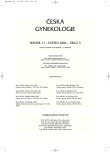Effect of Early Onset of Transdermal and Oral Estrogen Therapy on the Lipid Profile: a Prospective Study with Cross-over Design
Vliv časně zahájené transdermální a perorální estrogenní substituční terapie na lipidový profil – prospektivní studie s cross-over designem
Cíl studie:
Cílem studie bylo zjistit změny lipidového profilu při různých aplikačních formách estrogenní substituční terapie (ERT).
Typ studie:
Prospektivní randomizovaná studie.
Název a sídlo pracoviště:
1. LF UK a Všeobecná fakultní nemocnice, Praha.
Metodika:
V 12týdenní intervenční studii byl v cross-over designu podáván estradiol perorálně v dávce 2 mg nebo transdermálně v dávce 50 μg denně. Zařazeno bylo 45 zdravých postmenopauzálních žen do 12 týdnů od chirurgické kastrace s průměrným věkem 49 ± 6 let. Studii dokončilo 41 žen a jejich data byla analyzována. Odběry žilní krve byly prováděny na počátku studie a v posledním týdnu každé léčebné intervence. Statistické zpracování výsledků bylo provedeno párovým t-testem.
Výsledky:
Celkový cholesterol se statisticky významně neměnil. Triacylglyceroly signifikantně (p = 0,004) vzrostly při perorální léčbě z 1,39 ± 0,9 mmol/l na 1,61 ± 0,8 mmol/l. To spolu s nesignifikantním (p = 0,187) trendem k poklesu u transdermální léčby vedlo k označení rozdílu v jejich působení za významný (p = 0,0001). Příznivý vzestup HDL z 1,85 ± 0,39 mmol/l na 2,09 ± 0,42 mmol/l (p = 0,0001) po perorální léčbě je signifikantně (p = 0,009) vyšší než po transdermální terapii s vzestupem na 1,96 ± 0,42 mmol/l (p = 0,029). Také změny LDL jsou příznivější (p = 0,0001) pro perorální léčbu, kdy z iniciální hladiny 3,06 ± 0,97 mmol/l významně (p = 0,0001) poklesl na 2,52 ± 0,71 mmol/l, zatímco po transdermální ERT je pokles na 3,0 ± 1,0 mmol/l nevýznamný.
Závěr:
S výjimkou triacylglycerolů mají všechny ostatní hodnoty charakterizující metabolismus lipidů příznivější vývoj po perorální estrogenové terapii. Znalost lipidového profilu a jeho změn po jednotlivých modalitách hormonální terapie umožní přísnější individualizaci této léčby.
Klíčová slova:
hormonální substituční terapie, kardiovaskulární nemoci, lipoproteiny, cholesterol
Authors:
Tomáš Fait 1
; M. Vráblík 2; Z. Žižka 1; B. Trnková 3; J. Mašata 1; J. Živný 1
Authors‘ workplace:
Gynekologicko-porodnická klinika 1. LF UK a VFN, Praha, prof. MUDr. A. Martan, DrSc.
1; III. interní klinika 1. LF UK a VFN, Praha, prof. MUDr. Š. Svačina, DrSc. MBA.
2; Ústav klinické biochemie a laboratorní diagnostiky 1. LF UK a VFN, Praha, prof. MUDr. T. Zima, DrSc.
MBA.
3
Published in:
Ceska Gynekol 2006; 71(3): 226-230
Category:
Original Article
Overview
Objective:
The aim of study was to evaluate changes of lipid profil during different types of estrogen replacement therapy (ERT).
Design:
Prospective randomized study.
Setting:
1st Faculty of Medicine and General Faculty Hospital Prague.
Methods:
Two routes of administration were used for 12 weeks: oral estradiol 2 mg/day and transdermal estradiol 50 μg/day (7-day pathes). Forty five healthy women with average age 49 ± 6 years were randomised into prospective cross-over designed study. Forty one women finished the study and were analysed. Blood collections were performed from veins on the beginning of study and during last week of each therapeutic interventions. Statistical results have counted by paired t-test.
Results:
Total cholesterol levels were not changed. Triglycerides grew up from 1,39 ± 0,9 mmol/l to 1.61 ± 0.8 mmol/l (p = 0,004) after oral ERT. This results showed significant (p = 0.0001) differences between oral and transdermal application because of nonsignificant (p = 0.187) lowering trends after transdermal ERT. The elevation of HDL levels after oral ERT (from 1.85 ± 0.39 mmol/l to 2.09 ± 0.42 mmol/l, p = 0.0001) was significantly (p = 0.009) more favourable than after transdermal ERT (to 1.96 ± 0.42 mmol/l, p = 0.029). Changes of LDL levels are also more favourable (p = 0.0001). LDL levels decreased after oral ET from 3.06 ± 0.97 mmol/l to 2.52 ± 0.71 mmol/l in comparison with the nonsignificant decline on 3.0 ± 1.0 mmol/l after transdemal ERT.
Conclusion:
All data from lipid metabolism had more favourable changes after oral ET with the exception of triglycerides. Knowledge of the patient’s lipid profile and it’s changes after each type of estrogen applications enable doctors individualisation of hormone replacement therapy from this point of view.
Key words:
hormone replacement therapy, cardiovascular diseases, lipoproteins, cholesterol
Labels
Paediatric gynaecology Gynaecology and obstetrics Reproduction medicineArticle was published in
Czech Gynaecology

2006 Issue 3
Most read in this issue
- Discrepancy of Ultrasound Biometric Parameters of the Head (HC - Head Circumference, BPD - Biparietal Diameter) and Femur Length in Relation to Sex of the Fetus and Duration of Pregnancy
- Serum Antibodies against Annexin V and Other Phospholipids in Women with Fertility Failure
- Intrahepatic Cholestasis of Pregnancy – Four Case Reports
- Prevention of Rh (D) Alloimmunization in Rh (D) Negative Women in Pregnancy and after Birth of Rh (D) Positive Infant
